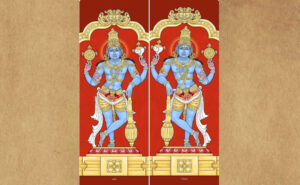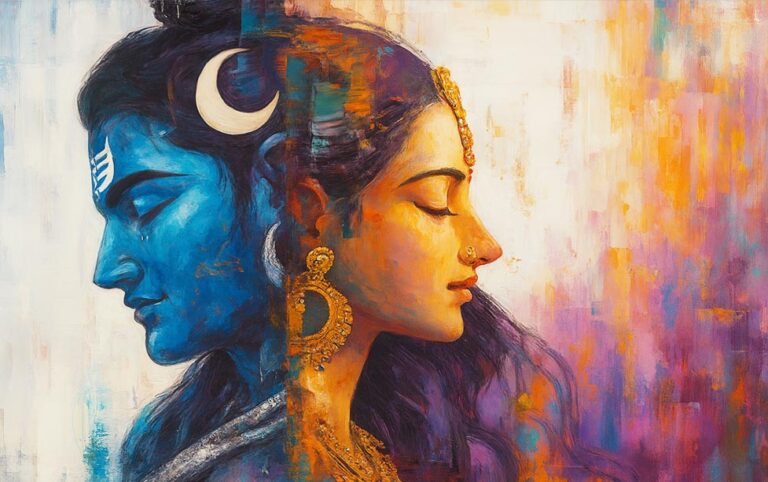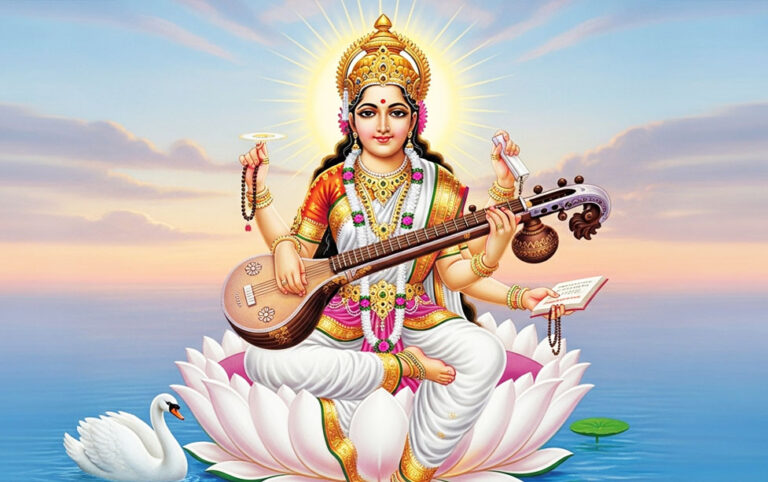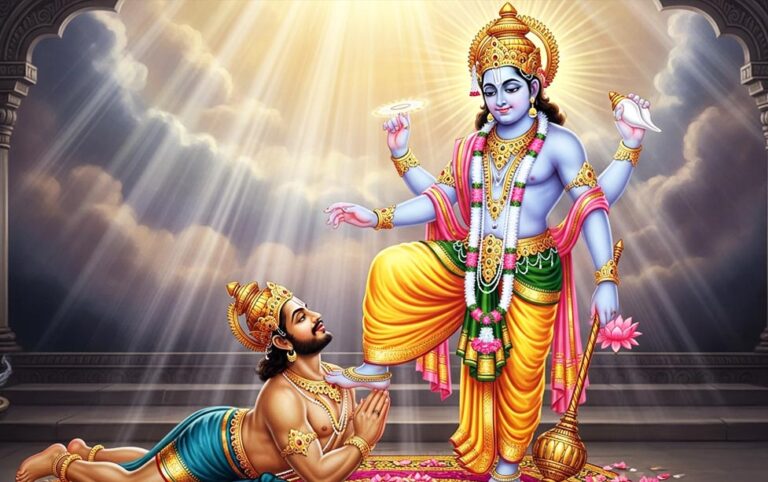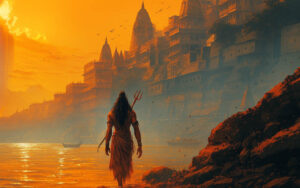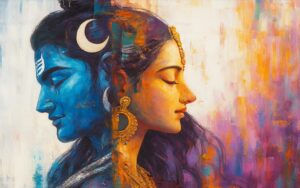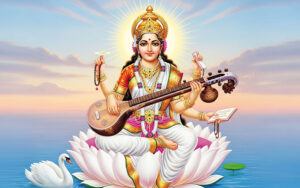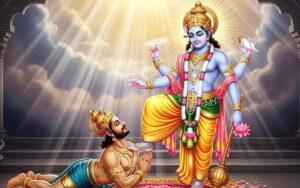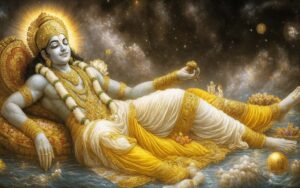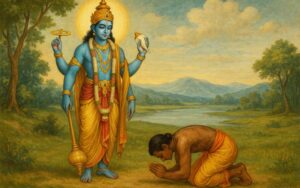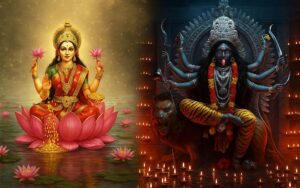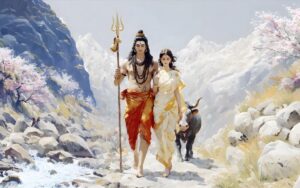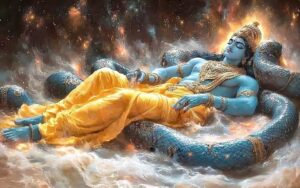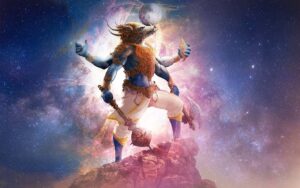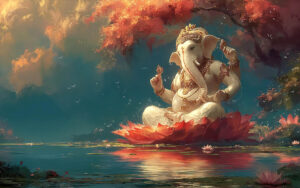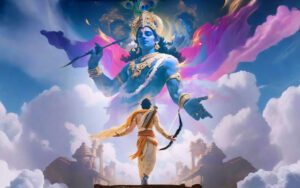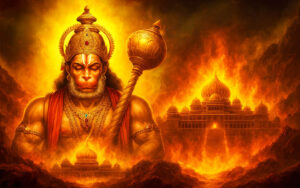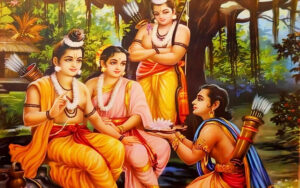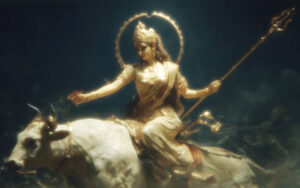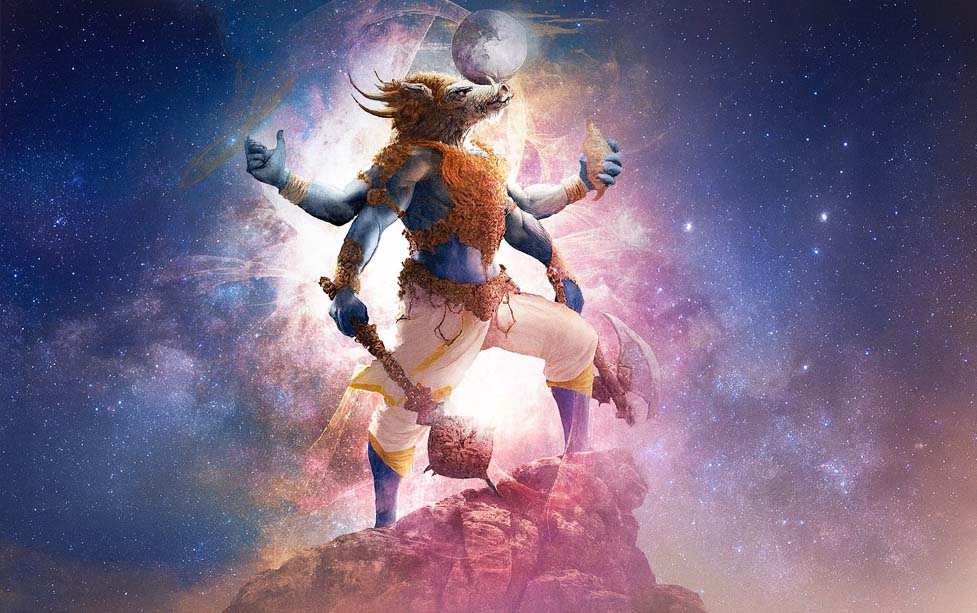
No time for reading the story? Give it a listen on Spotify.

Lord Varaha, the boar incarnation of Vishnu, descended to rescue Earth from the cosmic ocean and revealed the timeless wisdom of the Varaha Gita.
Characters in the story:
Varaha: Varaha is a boar avatar of the Hindu god Vishnu, who is believed to have appeared on Earth to rescue the Earth goddess, Bhudevi, from the demon Hiranyaksha, and to restore order and balance to the universe.
![]()
Bhudevi: Bhudevi is a Hindu goddess and is considered the personification of Mother Earth. She is often depicted as a woman with a green complexion and is worshipped for her fertility and abundance.
![]()
Hiranyaksha: Hiranyaksha is a demon king in Hindu scriptures who was slain by the god Vishnu in the form of the boar-headed avatar Varaha. He is known for his immense strength and his role in stealing the earth and hiding it at the bottom of the cosmic ocean.
![]()
Lord Vishnu: Lord Vishnu is one of the three major deities in Hinduism, known as the preserver of the universe and the protector of dharma (righteousness). He is often depicted with four arms holding a conch shell, a discus, a mace, and a lotus flower.
In the age when darkness veiled creation, a powerful demon named Hiranyaksha rose from the lineage of the sage Kashyapa. Blinded by pride and hatred toward the gods, he conquered the heavens and dove deep into the cosmic ocean, dragging Bhudevi (Mother Earth) with him. His goal was to unbalance the universe — to drown the world and reign over chaos itself.
As the Earth vanished beneath the waters, the gods turned to Lord Vishnu, the eternal protector. In response, Vishnu took the form of Varaha, the mighty Boar — radiant like a thousand suns, fierce and compassionate at once. From the nostril of Lord Brahma, he emerged first as a tiny boar, then expanded into a form so vast that his roar shook the heavens.
With a single leap, Varaha plunged into the cosmic ocean, his tusks cutting through waves of darkness. In the abyss, he found Bhudevi trembling, her light dimmed by despair. Gently, he lifted her upon his tusks — but Hiranyaksha appeared to challenge him.
A great battle ensued, shaking all realms. The clash between the demon and the divine lasted a thousand celestial years, until finally Varaha struck him down, ending his tyranny. Then, rising from the waters, he restored Bhudevi to her rightful place, and creation was once again in balance.
The Birth of the Varaha Gita
When peace returned, Bhudevi bowed before her savior and asked with deep compassion:
“O Lord, you have raised me from the depths of darkness. But tell me — how may all beings, trapped in the endless ocean of birth and death, find liberation?”
Moved by her question, Lord Varaha revealed a discourse of divine truth — the Varaha Gita, recorded in the Varaha Purana.
Like the Bhagavad Gita, it is a sacred dialogue — a conversation between the Earth and the Eternal, between matter and consciousness, revealing the secrets of creation, karma, and spiritual freedom.
The Teachings of Lord Varaha
Varaha explained that every soul is bound by karma and deluded by maya, the illusion that separates one from the Divine. Only through bhakti (devotion) and jnana (knowledge) — the two tusks of truth — can one rise from ignorance to liberation.
He revealed to Bhudevi that:
The universe moves in endless cycles of creation and dissolution, governed by divine rhythm.
The soul is eternal and unchanging, untouched by life or death.
Sincere devotion, humility, and remembrance of the Divine Name free one from the ocean of suffering.
Selfless action (karma yoga) performed with detachment purifies the heart and aligns it with divine will.
Meditation and inner silence help the soul perceive the Divine within itself — not as distant, but ever-present.
Rituals, fasting, and vratas, when done with faith and compassion, uplift both the devotee and the world.
The greatest virtue is compassion for all living beings, for all forms of life are sustained by the same Divine essence.
And finally, with a voice that resonated through creation, Lord Varaha declared:
“Those who surrender to me, O Bhudevi, are never destroyed by the waves of birth and death.”
The Spiritual Meaning
The Varaha Gita teaches that divine grace can lift the soul just as Varaha lifted the Earth — from darkness to light, from confusion to clarity. It reminds humanity that faith, wisdom, and compassion together form the path to liberation.
Varaha’s tusks symbolize knowledge and power, his battle with Hiranyaksha reflects the struggle between dharma and adharma, and his dialogue with Bhudevi embodies the eternal relationship between God and the world — spirit nurturing matter.
Legacy of the Varaha Gita
Even today, the teachings of the Varaha Gita are revered by devotees seeking protection, balance, and spiritual clarity. In ancient shrines like the Sri Varaha Swamy Temple in Tirumala, worshippers first offer prayers to Varaha before approaching Lord Venkateshwara — honoring the protector who once raised the world from the deep.
The message of the Varaha Gita endures:
The Divine never abandons creation.
Through devotion, wisdom, and compassion, every soul can rise from illusion into the light of truth.


